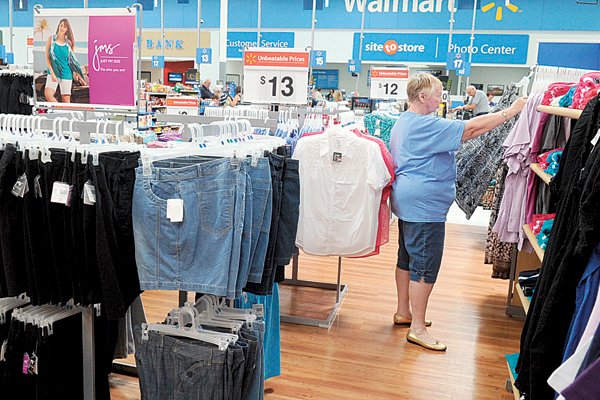Eduardo Castro-Wright, Wal-Mart Stores Inc.’s vice chairman in charge of U.S. operations, raised some eyebrows when he told reporters after the company’s annual shareholders’ meeting that apparel “isn’t our most important business” and called it a “work in progress.”
Granted, apparel accounted for only 10 percent of sales in the company’s most recently completed fiscal year, down 2 percent over the past two years.
That still makes it a $40 billion-a-year business and one that produces higher margins than groceries, which rose to 51 percent of overall sales, up 2 percent from the previous year.
Perhaps he meant “fashion,” or “fast fashion,” a territory into which the company ventured and stumbled earlier this decade.
Speaking to reporters, Castro-Wright said: “I can summarize it by saying that we are going back to basics in many ways. Basics, as in business basics, and basics, literally, in terms of the product itself. We do extremely well when we sell everyday needs for our customers, anything from socks and underwear to jeans and T-shirts. That’s where we excel and that’s where our value proposition can differentiate us from other retailers.”
Those basics apparently go a long way, given the retailer’s large scale. Recent shopper surveys by BIGresearch of Worthington, Ohio, found that Wal-Mart remains the top apparel-shopping destination in several categories.
For women’s clothing, 13.5 percent picked Wal-Mart, followed by Kohl’s at 10.1 percent.
Men’s: Wal-Mart 17.8 percent, Kohl’s 13.5 percent.
Children’s: Wal-Mart 14.5 percent, Target 5 percent.
Wal-Mart also held the top spot for shoe-shopping at 14.5 percent, followed by discounter Payless Shoe Source at 10.6 percent.
Paula Rosenblum, a Miami-based partner in Retail Systems Research LLC, said Castro-Wright’s assessment of Wal-Mart’s apparel business was a “noble” statement. Wal-Mart’s core competency, she said, is stocking and sell-ing commodities on a grand scale, efficiently, and at a low price.
“Bringing them [customers] fashion-forward clothes is not really part of the core value,” she said. “You can’t be all things to all people.”
Fashion changes rapidly, Rosenblum said, and the company also has a perception problem among many shoppers that if an apparel item came from a Wal-Mart store, it can’t be “cool.”
But not to worry, she said,“there’s plenty of margin in socks and underwear.” And Hanes underwear likely will look the same next year, she said, which means there’s no need to tinker with the supply chain.
Camille Schuster, a California marketing professor and retail consultant, said Wal-Mart’s supply chain is designed for a “nice, continuous replenishment” of what the company has on its store shelves.
Fashion, she said, requires the flexibility to change out what’s hanging on the store racks in a matter of weeks. If Wal-Mart sticks with basic types of clothes in attractive colors, she said, “I think they’ll do just fine.”
“Don’t market it as fashion forward,” she said.
Rival Target Corp., Schuster said, has developed a strong collaboration with designers and manufacturers over the years and can identify trends and replenish what’s popular in short order.
Target reported that apparel accounted for 20 percent of sales in its most recently completed fiscal year, unchanged from the previous year and down 2 percent over two years. That would put its apparel sales at about$13 billion.
Wal-Mart recently tweaked staffing assignments in its apparel division, which has a design office in New York, home to much of the fashion world. Lisa Rhodes, senior vice president, now runs the apparel business with general manager Dottie Mattison, to whom Rhodes previously reported.
Both report to John Fleming, chief merchandising officer.
Wal-Mart’s apparel brand lineup includes Faded Glory, Danskin, Starter, OP, Norma Kamali and No Boundaries.
Carol Spieckerman, a Bentonville retail consultant and partner in new market builders, is convinced that Wal-Mart can rejuvenate its apparel business and is disappointed that the company pulled back from its ventures into the fashion world, which included advertising in Vogue magazine.
Apparel, she said, “is still too much of an accidental business for Wal-Mart.”
In cosmetics, she said, the company turned its beauty area into a “meaningful destination” that is well-executed.
One misconception, she said, is that Wal-Mart shoppers are not into fashion.Those shoppers are researching trends online and in fashion magazines and know what’s happening, she said.
“I think the Wal-Mart customer is absolutely aware of fashion,” she said.
Spieckerman also credits Wal-Mart with offering a wider range of plus sizes through its collaboration with designer Norma Kamali. She’s less impressed with the Miley Cyrus/ designer Max Azria leopard pants, which she argues send a mixed message.
But generally in the fashion world now, Spieckerman said, “everything is pretty trendless.”
Business, Pages 67 on 06/20/2010
